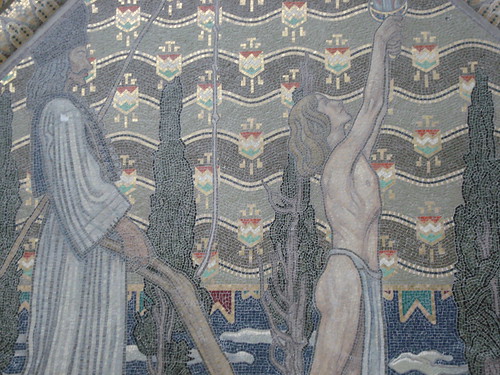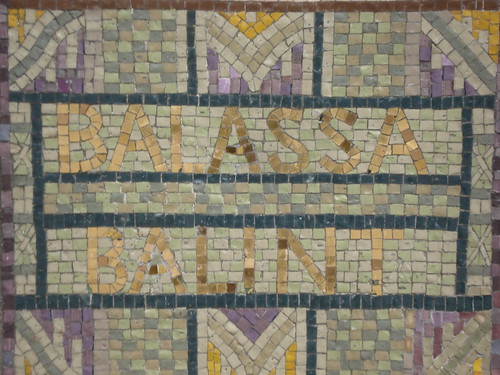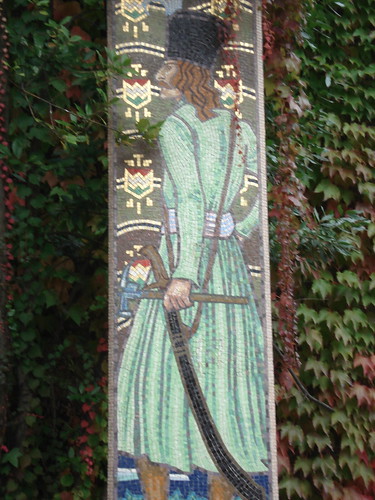 |
| We defeated the enemy with weapons. We will get bread with work. To work comrades! Nikolai Kogout, 1920. |
The
Pushkin House in Bloomsbury is the venue for
Visions of Utopia - an exhibition of 25 Soviet posters from the 1920's and 1930's, on loan from the Marx Library collection. The posters tell a story of a brave new world as the Soviet Union asserted its identity in the two decades following the
revolution of 1917.
As with many other ideologies, the Soviet Union made use of art to influence, inspire and intimidate the general population into supporting, or at least complying with the regime. The Soviets had the advantage of access to some of the world's greatest artists to create visual propaganda for them, carrying simple but effective messages in a visually stunning format. Furthermore at least for the early years of the Soviet Union, many leading artists were supporters of the regime, albeit with varying degrees of enthusiasm. Of course this was to change during the Stalinist period as creativity was largely suppressed and man artists murdered or exiled.
A number of artists chose to devote themselves to the poster format. Perhaps the most influential of these, and the focus of the current exhibition, was
Gustav Klutsis. A committed communist, Klutsis had been a member of the
Latvian Red Rifles and even acted as a guard to Lenin at the Kremlin in 1918. He studied at
VKhUTEMAS as did many of the leading constructivists, working alongside such luminaries as Kazimir Malevich, EL Lissitzky and architect
Vladimir Tatlin. Whilst at VKhUTEMAS he had joined the Communist Party as well as meeting and marrying long time artistic collaborator
Valentina Kulagina.
 |
| Komsomol to the shock work of the seasonal sowing. Gustav Klutsis, 1935. |
Much of his work was joyful and utopian as witnessed by his 1931 poster
Komsomol to the shock work of the seasonal sowing with
the young Soviet pioneers on their way to the fields, armed with the technology of the tractor, the red flag and their smiling enthusiasm. But even at this stage the Soviet Union had entered a much darker, more repressive time and just four years later the artist's talents were being used to deify Stalin and not the workers.
Long live our happy socialist homeland. Long live our beloved great Stalin from 1935 takes a very different approach to the 1931 poster. The focus has completely changed from the achievements of the workers to the cult of Stalin on whom everyone and everything has become dependant, hence the adoring gazes of the children, workers and the military salutes. By 1935, the atmosphere in the Soviet Union had deteriorated significantly ahead of the
great purge of 1937-38 when thousands of artists, intellectuals and those deemed opponents of the regime - including some of its leaders - were executed or simply disappeared.
Klutsis himself was to become a victim of the purge, disappearing in 1938 when preparing to attend the New York Worlds Fair. It was not until 1989 that it became known that he had been executed on Stalin's instructions.
 |
| Long live our happy socialist homeland. Long live our beloved great Stalin! Gustav Klutsis, 1935. |
Posters have long been used to promote a specific issue or event. The Soviets also recognised this and chose to tackle a number of social issues through this medium. The exhibition includes some examples of this - promoting the new rapid transport metro system (one of the Soviet Union's major and lasting achievements), encouraging the miners to work harder and most intriguingly, an undated poster by an unknown artist bearing the legend
Anti-semitism is deliberate counter-revolution. The anti-semite is our class enemy. How very true. What a shame that such honourable words were never enacted and that
anti-semitism was state orchestrated in different ways for most of Soviet period. It would be interesting to know more about the artist and what happened to her or him.
Gender equality was also depicted through propaganda posters. An example of this from the exhibition is Nikolai Kigout's
We defeated the enemy with weapons. We will get bread with work. To work comrades from 1920 (see the top of this post). The poster shows male and female workers contributing equally to building the state, with the hammer wielding women to the foreground. Little is known about Kigout, but he was a prolific artist and you can see more of his work
here.
Another one of the earlier posters, from 1925 is stylistically different to the other works. Luke Emelianov's
Fight the vermin shows a traditionally dressed peasant threatening a caterpillar and a rat with a book entitled
Co-operation. In the early years of the Soviet Union, a small degree of private enterprise was allowed in order to stimulate the economy, but by the mid 1920's this was already being discouraged. The caterpillar represents the
kulaks - peasants with small private holdings who became the focus of state persecution resulting in the deaths of millions, whilst the rat represents capitalist private trade. The building to the rear of the poster is a collective farm, shown as the way forward and a way for the equitable distribution of resources. Unfortunately the
forced collectivisation of farms also proved disastrous for many.
 |
| Fight the vermin. Luke Emelianov, 1925. |
My final illustration does not form part of the exhibition but is featured in the book,
the Art of the Revolution which is illustrated by posters from the Marx Library collection.
Odessa: A Tourist's Paradise dates from 1935 and features the famous Odessa steps, scene of a Tsarist massacre of peaceful protestors in 1905 captured for all time in Sergei Eisenstein's film
Battleship Potemkin. I include it because it shows the possibility of a healthy, happier life during Soviet times, although by 1935 this possibility was limited to very few people and many of those would die in the great purge just a few years later. I also include it because the colours and the optimism of the image remind me of my visit to Odessa in 2009 and of the city's relaxed, seaside feel.
 |
| Odessa, a tourist's paradise. Artist un known, 1935. |
The Marx Library collection was built up by a number of political activists who visited the Soviet Union in the 1920's and 1930's returning with copies of then current art and propaganda posters with the intention of inspiring the British working class to action. The collection also has posters from Weimar Germany, France and the former Czechoslovakia.
The
Pushkin House has an extensive programme of exhibitions, readings, recitals and other Russian cultural activity - much of it free.
Visions of Utopia continues until 5th December.
You might also like
Moscow avant-garde and constructivism and
Soviet Posters of the Silent Screen at London's GRAD


















